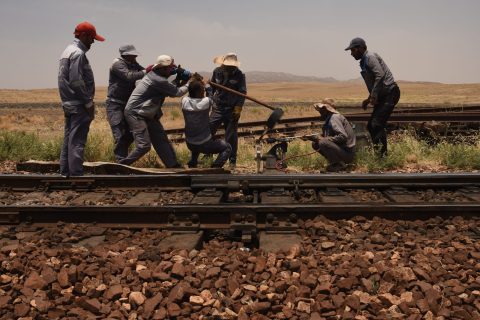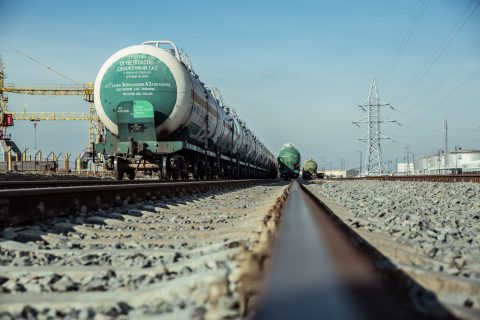What do you do when the train to Europe takes longer than a ship?

The main border between China and Kazakhstan has been congested since the start of June. By the end of the month, this had resulted in delays of two weeks for freight trains from China to Europe. The summer holidays are known as a peak period, but this is not like other years, says Mike Liu, General Manager of CMC Logistics. The cargo volumes on the New Silk Road are higher than ever before.
Liu discussed the current situation at the Alashankou-Khorgos border in the studio of RailFreight Live last Friday. Representing a Chinese (Taiwan) forwarding company in the Netherlands, he deals with the consequences of the congested border on a daily basis. “At the moment the total train transit time is even longer than ocean freight. This really harms the confidence of customers in rail freight transport.”
Possible cause
Although there is no consensus over the exact cause of the congestion, Liu and colleagues have noted two possible reasons, which influence each other and double the effect. “First, there is an imbalance in the numbers of westbound and eastbound trains. Containers need wagons, but the number of wagons that come to Europe is much higher than the number of wagons that returns to China. As a result, there is a shortage of wagons.
“The second cause is the booming rail freight business since the pandemic. This has really pushed the volumes at border to another level, way above the operational capacity. Such situation only increases the gap of incoming and outgoing wagons.”
Indeed, the companies operating the trains all report record volumes since the market in China has restored. In the first half of the year, Alashankou Customs handled a total of 2,128 trains and 192,000 TEUs, which is an increase of 50.5 per cent (Europe-bound) and 41.4 per cent (China-bound) compared to the same period last year. On top of that, the border point of Alashankou-Khorgos is the most used border crossing on the New Silk Road. Much less traffic runs via Erenhot or Manzhouli. “The share handled by this border point is understood to be more than 70 per cent”, Liu said.
Additional departures
The volumes started to surge in March, when China was slowly recovering from a pandemic and consequent lockdown. Rail proved to be a popular transport mode, as the prices of air cargo were shooting up and ocean freight was simply taking too long for those products that had a backlog. However, the European market was now experiencing a lockdown in most industries. Nevertheless, May was considered a record month by many, followed by an even exceeding month of June.
“The expectation is that congestion will slow down by the second half of July”, said Liu. This is not necessarily because of a slowdown in supply. At the moment only regular trains are given a green light by the Chinese authorities, in order to free up space at the border. Due to the limited capacity after the pandemic, some rail companies increased their train departures from China, and those are additional to the originally approved train schedule. At first, China Railway was open to give the green light to those additional train schedules, until it was really too much and started hurting the whole market in June. It then decided to turn down all of the additional train schedule requests.”
What could help
“We foresee the demand of China trains will continue to grow” said the forwarder in RailFreight Live. “In general, the facilities and infrastructure need to be improved to increase the transloading capacity, and so does the number of wagons. In the meantime rail companies really need to reduce the gap between eastbound and westbound traffic. The first is happening, but not due to be completed in the short term. We do start to see some efforts of rail companies pushing the eastbound business.”
What could also help, is better preparation of paper work, Liu added. “Document preparation in an earlier stage always helps, we sometimes see customers spend a lot of time on the document communications.” Other measures such as palletizing the goods may not help too much, he thinks. “This could only earn maximum half a day. However, people send loose cargoes without pallet for their reasons, space utilisation will go down and the rail freight unit cost will go up.”
LCL shipments
CMC Logistics is specialised in less-than-container-load (LCL) shipment, a niche section in the rail freight industry. LCL shipment is mostly time sensitive. Does this mean that the hit is extra hard? Liu believes the opposite is true. “The impact is less. The congestion makes China Railway more conservative, and by that it reduced the total container space supply. However, most of the LCL consolidators regularly deal with rail companies to reserve the consolidation container space. So although the total transit time is still affected, at least it is better than having no space for full-container-load (FCL) shipments.
“But, we also know that air freight prices start to go down. They are still much higher than last year, but not at an extreme level anymore. So, if the delay caused by congestion lasts too long, I think some of the LCL bookings may be squeezed to air freight, or even ocean freight. But this shouldn’t be a big portion.
Pattern of congestion
It is not the first time the New Silk Road faces congestion. In fact, there is a certain pattern, most industry experts believe. For example, the start of European summer holidays are known to cause congestion. “During the summer holiday it is always peaceful, and then we see congestion again in about September/October, after the summer holiday. I wouldn’t say there is a regular seasonal congestion at border points, but somehow congestion is triggered by the higher demand in Europe”, says Liu.
Given that fact, shouldn’t there be more anticipation from those parties experienced on the market? “It is hard to predict the business pattern of this year”, says Liu. “The congestion of this year has different reasons. I don’t know if people still go for holidays, and if so, maybe not like before. Secondly, the increase of volumes is not because of the holiday season.”
And it does not stop with congestion at the border. Although this may already be easing, the after effects are still felt in full swing. “Trains are all on the same track; if at a certain location there is congestion for any reason, the next checkpoint will need to manage all trains coming at the same time, without interval. Within a short time, congestion will appear there too and the operational pressure will become too high.”
Positive effect
At the same time, there is a positive effect of all of this too, the forwarder says. “It gives the authorities a warning. I think rail freight between China and Europe is still under development. This problem pushes the authorities to think of solutions, like improving facilities and infrastructure. This may take time, but at least they start.
“Of course, we also received a lot of complaints and we need to deal stressful situations on a daily basis. But China Railway has already reduced the train departures and in the past 2 weeks the border has already reduced most of the backlogs, so we think this congestion at the Chinese border could be resolved in the second half of July.” That is not to forget that congestion may occur in Europe very soon, he warned. “We still need to see how operations work out on the European border.”
You just read one of our premium articles free of charge
Want full access? Take advantage of our exclusive offer





